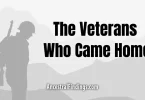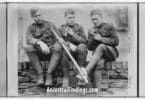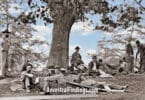Veterans Day calls us to remember, but for genealogists, it also opens a door to discovery. Behind every name in a family tree, there may be a record of service—one that shaped not only a life but an entire line of descendants. When we trace the veterans in our families, we do more than learn about wars and uniforms; we uncover courage, hardship, and the choices that built the generations that followed.
Researching military ancestors is one of the most rewarding forms of family history. It connects individual lives to major events in history and often reveals personal details found nowhere else. With patience and the right approach, you can build a clear record of your family’s service across the centuries.
Where to Begin
Start with what you already know. Look through old photographs, letters, and papers that might mention military service. A photo showing a uniform, a medal, or a shoulder patch can be a clue. Family Bibles sometimes record service dates beside names. Even a short note such as “served in France” can guide your search.
Cemeteries offer valuable evidence. Military headstones or inscriptions often include unit names and wars served. The Department of Veterans Affairs maintains a public gravesite locator that helps identify burial sites for many veterans.
Census records can also help. The 1910, 1930, and 1940 U.S. censuses include questions about military service. County histories, school yearbooks, and church memorials may list local men and women who served in particular conflicts.
Major Eras of Military Service
Each period of American history has its own kinds of records and repositories. Knowing the right era will guide your research to the best sources.
Revolutionary War
For ancestors living between 1775 and 1783, look for pension and bounty-land records. These were filed by veterans or their widows and often include family information, dates of marriage, and descriptions of wartime experiences.
The National Archives holds these collections, and digital versions appear on Fold3 and the Daughters of the American Revolution’s online system. Bounty-land applications may trace later migrations westward, revealing where a family settled after the war.
War of 1812
The pension files for this war are among the most informative of any early conflict. They often include witness statements, property details, and supporting documents from local courts. Many of these files are freely available online through partnerships between genealogical societies and archives.
Civil War
Almost every researcher eventually reaches someone touched by the Civil War. Begin by determining whether the ancestor served for the Union or the Confederacy. Union service and pension records are stored at the National Archives and can be ordered directly. Confederate files are divided among state archives and the National Archives.
Regimental histories, local memorial books, and state adjutant general reports help place soldiers in context. These sources show where a regiment traveled and what battles it faced, adding depth to the story.
Spanish-American War and Early 20th Century
Records from 1898 through the early 1900s bridge the gap between the Civil War and World War I. They include muster rolls and discharge papers that describe overseas duty and later veterans’ benefits.
World War I
World War I draft registration cards are an excellent place to begin for men born between 1873 and 1900. Every man registered, even if he never served. These cards provide full names, birth dates, residences, occupations, and physical descriptions.
Many official service records from this period were lost in a 1973 fire at the National Personnel Records Center, but other materials survive. State archives, local newspapers, and unit histories can often fill in what the federal files no longer contain.
World War II
Draft cards and enlistment records from the 1940s are widely available online. They list next of kin and occupation, and they can help you identify relatives who served even briefly.
The 1973 fire also destroyed many World War II files, but replacements known as final pay vouchers, hospital admission cards, and morning reports may still be available. Local newspapers and honor rolls often published stories and photographs of returning soldiers, providing a personal glimpse into the war years.
Korea, Vietnam, and Later Conflicts
For veterans of the more recent wars, privacy laws restrict public access to records, but family members can request service files through the National Personnel Records Center. A copy of the DD-214 discharge form confirms dates of service, rank, medals, and honorable status.
Community newspapers, veterans’ groups, and reunion websites can also supply context and photographs for these generations.
Reading and Interpreting Military Records
Military records are more than lists of dates and units. They are personal documents that capture a person’s life at a specific time. An enlistment paper may describe height, weight, eye color, and even handwriting. Muster rolls can show when a soldier was promoted, transferred, or hospitalized. Pension files may contain letters written long after the war, describing illness, loss, or financial hardship.
When you read these materials, take time to note every detail. Residences, family names, or witnesses can lead to new branches of research. Use maps to trace where regiments traveled, and learn about the larger events surrounding their movements. The more context you gather, the more your ancestor’s experience becomes real rather than abstract.
Service Beyond the Battlefield
Many family members contributed to military efforts without being enlisted soldiers. Women served as nurses, clerks, and factory workers. During the Civil War, groups like the U.S. Sanitary Commission supported hospitals and supply lines. In both World Wars, the American Red Cross and the Women’s Army Corps offered service opportunities that generated records of their own.
Local historical societies and libraries often hold rosters of these workers. City directories from wartime periods may list occupations connected to defense industries. These sources broaden our understanding of service, showing that sacrifice took many forms.
Preserving and Protecting Records
Once you’ve gathered your findings, preserve them carefully. Original discharge papers, medals, and photographs should be stored in acid-free sleeves or boxes in a stable environment. Avoid attics or basements where temperature and humidity vary.
Digitize everything you can. A scanner or high-quality camera allows you to create permanent copies that can be shared with relatives. Include full citations—record group numbers, archive locations, and digital source links—so future researchers can verify your work.
Consider contributing copies to institutions such as the Veterans History Project at the Library of Congress. Local museums, archives, and genealogical societies often welcome materials that document community military history. Sharing these records ensures they remain part of a lasting public archive.
Building the Story
Once the research is complete, take time to tell the story. Write a short biography for each veteran in your family, describing where they lived before enlistment, what unit they served with, and how the experience may have shaped their later life. Include photographs and maps to help readers visualize their journey.
This kind of writing transforms genealogy into history. It turns scattered facts into a family narrative that others can understand and appreciate. These stories remind us that service was not anonymous—it was carried out by people whose descendants are still here to remember them.
Continuing the Research
Military research often leads to unexpected discoveries. You may find multiple generations who served in different wars or relatives who followed each other into the same branch of service. Tracing these patterns can show how values of duty and resilience traveled through a family line.
Keep track of every source and note your progress. Many researchers maintain a separate military logbook or database for each ancestor. This habit prevents confusion and makes it easier to update information as new databases appear online.
Reflection
To study the veterans in your family is to see history through personal eyes. It transforms wars from distant events into stories of real people who lived, endured, and returned home to raise the next generation. Veterans Day is a reminder to seek those names, preserve their records, and share what you find.
Each pension file, medal, and photograph tells a story of service that shaped both a nation and a family. When we gather those stories, we preserve more than facts. We protect memory itself—so that courage, faith, and endurance remain part of the living record of who we are.






